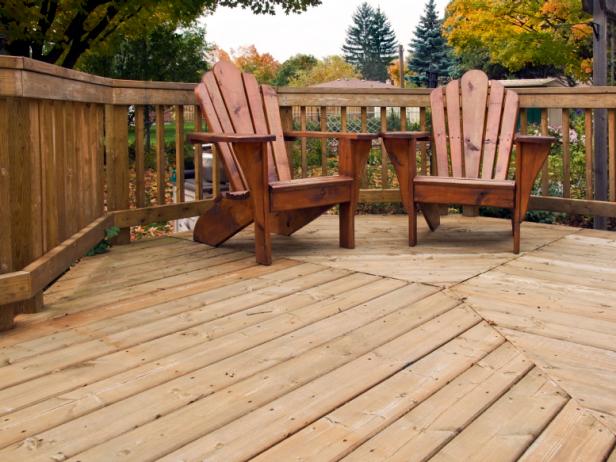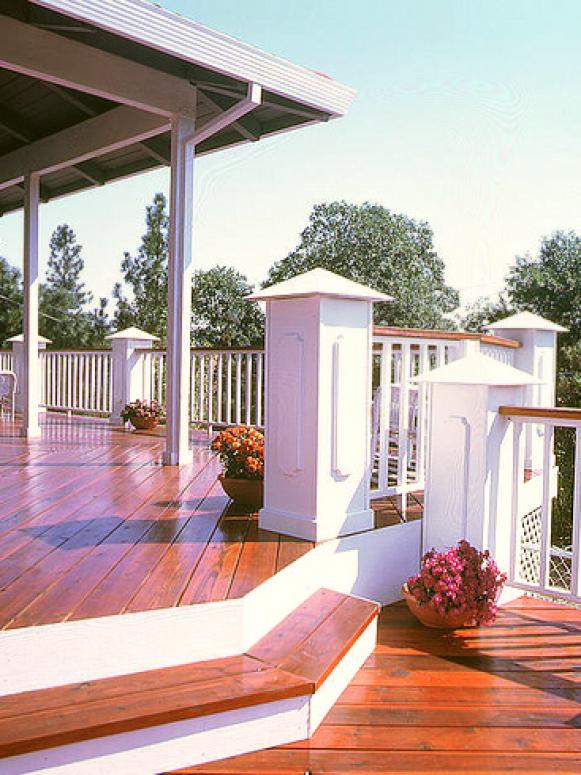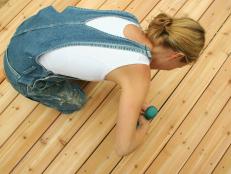Wood Decking Materials

Lydia Dotto, ImageInnovation Photography
While most of the structure of the deck is made of pressure-treated lumber and sometimes steel beams, the actual decking is the part you walk on. It can be made of wood, plastic (PVC) or a composite material that combines plastic with wood fibers. Here are some tips when selecting decking materials.
Wood Materials
The three common choices when it comes to wood decks are redwood, cedar and pressure-treated wood that can be made of various types of wood species. Redwood and cedar are both naturally insect and rot resistant and have a natural look, but each has its own inherent issues.

Redwood Decking
Redwood needs to be maintained by applying a sealer and reapplying it over time. It's also more expensive the farther away from the West Coast of the United States you live, as that's where it's grown. "As a decking material, it's naturally stable, so it resists warping," says Gordon Whittaker, owner of Alter Eagle.
Redwood's stability helps it look great longer. It contains little or no resins, which enables it to retain finishes. "From an environmental standpoint, the choicest redwood is from old-growth trees and the supplies are dwindling," according to Tim Keating, executive director of Rainforest Relief, the lead U.S. organization trying to slow deforestation in the tropics and the U.S. "We're now down to 1 percent of the old-growth (redwood) trees," Tim explains.

Cedar Decking
Considered a soft wood, cedar has been used for decking for generations. Its natural resistance to rot and insects makes it desirable, however, it might to be too soft for decking and has a tendency to splinter, according to Gordon Whittaker. It's best used for vertical elements like the balustrade of the railing, privacy fencing or for structures like pergolas and planters. Again, the Rainforest Relief organization would argue that old-growth cedars of 100 to 250 years old, where the choicest cuts come from, are in danger of being destroyed forever.

Pressure-Treated Lumber
Pressure-treated lumber is rot and insect resistant, but it's cheaper than redwood or cedar and is widely available across the U.S. Deck builders use it to build the support systems for decks because it holds up well and is often masked by the deck flooring.
The problem with this type of wood is that it can be unstable, especially at lower prices. Shrinking, warping and twisting are all common with lesser-grade woods. If possible, pay a premium for higher-grade lumber that is treated at the mill with water repellents and sometimes pre-stained.
Other Wood Materials
Mahogany, teak and ipe all have their pros and cons. While beautiful and long lasting, mahogany is extremely pricey. For a large decking job, it will increase the cost significantly. Environmentalists question the reliability of claims that mahogany shipped to the U.S. is logged legally.
"We look at the FSC (Forestry Stewardship Council) with a jaundiced eye," says Tim. Teak is preferred for its beauty and durability, and comes from South America and Mexico, where it is not considered a native plant and is plantation grown. Previously, teak came from Southeast Asia into the U.S.
Ipe is a natural hardwood used in the 1960s for boardwalks at Coney Island, N.Y., and in the 1980s in Atlantic City, N.J. According to Tim, it is illegally logged from old-growth forests in South America and is not environmentally sustainable, although deck builders do use it.
"Ipe is stamped as coming from managed forests and not taken from natural habitats," says Gordon. "It is one of the strongest, affordable hardwoods and is mildew and termite resistant." Its smooth finish and tight grain means no splinters, but its hardness makes it difficult to work with and therefore drives up labor costs.




































